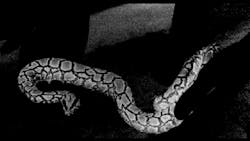Hyperspectral reflectivity detects pythons in the Everglades
Researchers from the University of Central Florida’s (Orlando, FL, USA; www.ucf.edu) College of Optics and Photonics and the University of Florida (Gainesville, FL, USA; www.ufl.edu), along with researchers from imec (Kissimmee, FL, USA; www.imec-int.com) and experts at Extended Reality Systems (New Smyrna Beach, FL, USA), have devised a way to use hyperspectral imaging to detect one of the most dangerous species in the Florida Everglades.
Between 1970 and 1990, Florida residents released an unknown number of Burmese pythons, likely as unwanted pets, into the Everglades. Today, it is estimated that the Burmese python population of the Everglades may approach between 100,000 and 150,000. The mammal population in Everglades National Park has accordingly suffered, with stunning decreases in the frequency of raccoon, opossum, and bobcat observations, and a seeming eradication of rabbits.
Infrared sensors are not very effective in the detection of cold-blooded animals. The research team instead decided to focus on using hyperspectral reflectivity measurements, with the hypothesis that detecting the difference in reflectivity between Python skin and the plant growth in the Everglades would allow the snakes to be readily detected by the python hunters tasked by the state of Florida to combat the infestation.
To gather reflectivity data, the researchers used an imec 2 MPixel SNAPSCAN hyperspectral camera system, with C-Mount lens and USB 3.0 interface. The camera was set to measure a spectral cube of 160 spectra at 2048 x 2048 resolution, with a cube acquisition time of approximately 12 seconds.
Samples that required studying were placed in an opaque 60 x 60 x 120 cm box painted on the inside with flat, white Rust-oleum paint to provide diffuse and spectrally flat reflections from four Osram (Munich, Germany; www.osram.in) Halogen Decostar 51 ALU 41861 WFL lamps with Thorlabs (Newton, NJ, USA; www.thorlabs.com) DG20-120 ground glass diffusers.
Data was taken from three Burmese pythons, two live, one dead and frozen (but mostly thawed prior to measurements being taken). The measurements discerned three regions on the python’s skin, dark and light regions of their scale color patterns, and underbelly regions.
The researchers knew from Python experts from the University of Florida and the state’s 20 authorized python hunters that pythons were usually detected on the side of gravel roads, camouflaged by both live and dead vegetation. The researchers therefore took hyperspectral scan data from ten live and ten dead samples of the type of vegetation in which pythons were often found, such as palm leaves and stalks, oak leaves, grass, and weeds.
The overall reflectivity of the pythons was much lower than the reflectivity of the vegetation, particularly in the bands above 750 nm. The researchers developed a prototype camera that responded to 850 nm light and inverted an image of a python surrounded by vegetation. The pythons were easily discerned in the image, demonstrating the potential for an inexpensive hyperspectral imaging device that could assist hunters in their fight against the python infestation.
About the Author

Dennis Scimeca
Dennis Scimeca is a veteran technology journalist with expertise in interactive entertainment and virtual reality. At Vision Systems Design, Dennis covered machine vision and image processing with an eye toward leading-edge technologies and practical applications for making a better world. Currently, he is the senior editor for technology at IndustryWeek, a partner publication to Vision Systems Design.
